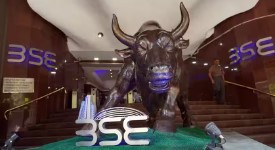Union Finance Minister Nirmala Sitharaman highlighted
the significant aspects of as well as geopolitical challenges to the
India-Middle East-Europe Connectivity Corridor or IMEC, one of the most
promising connectivity projects.
She added it would be a win-win situation for all
stakeholders, who are involved in bringing efficiency in transportation,
reducing logistic costs, increasing economic unity, generating employment, and
lowering greenhouse gas emissions.
“However, it is not without its geopolitical
challenges and the ongoing conflict in Israel and Gaza is a worrying
manifestation of these,” noted Sitharaman.
Praising the Indian economy for being on the right
track and heading towards a bright future, the Finance Minister asserted, “Bharat
is expected to overtake Japan and Germany to emerge as the third largest
economy in the world by 2027.”
“The country’s economic growth is estimated to be just
under 7 per cent during the year, the highest among major economies, despite
global headwinds,” she said while addressing the Indo-Pacific Regional Dialogue
here.
As far as the IMEC project is concerned, it was signed
at the 18th G20 Summit held in New Delhi on September 9-10 this, marking the
culmination of Bharat’s G20 Presidency.
“It is a multi-modal economic corridor that
incorporates multiple networks of shipping, railways, and roadways and will
also include electricity cables, high-speed data cables, and a hydrogen
pipeline,” said Sitharaman.
On the country’s growing economy, she said amidst
supply-chain disruptions and economic turbulence due to current conflicts that hit
the Indo-Pacific, irrespective of whether they are occurring in relatively
distant Ukraine or in relatively-proximate Israel or Yemen, and despite the
palpable tensions prevalent in the South- and East China Sea, the Indian
economy stands out as a bright spot.
“Even according to the usually conservative estimates
of the IMF, the Indian economy is set to emerge as the world’s third largest
economy by 2027, hopping over Japan and Germany, as its GDP crosses the $5
trillion level. By 2047, India aspires to be a developed economy,” she said,
adding that India’s ‘blue economy’ accounts for roughly 4 percent of the GDP
and represents a sea of opportunities.
She stated Bharat has remarkably improved its position
as a well-governed and innovative country with a conducive environment for
business as reflected in many global indices.
“Noting that the country’s comprehensive national
power is going to remain inextricably linked to the ocean, Bharat is seized of
the pressing need to grow the maritime sector as a whole and the government is
determined to provide the requisite support by way of fiscal policy and
financial outlay,” she said.
Talking about the maritime growth in the country, she
said Bharat has 9 States and 4 Union Territories situated on the coast, 12
major and 200+ non-major ports situated along its coastline, and a vast network
of navigable waterways for international and domestic trade.
“Our experience of the maritime manifestations of the Covid
has led to shipping insurance, too, becoming a particular area of policy focus,”
the finance minister added.
NE Watch Desk
















